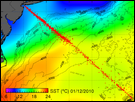Frequently-repeated XBT Transects
Frequently-repeated XBT transects are mostly located in tropical regions in order to monitor strong seasonal to inter-annual variability. These transects typically run north/south, and cross the equator or intersect the low latitude eastern boundary. They are intended to capture the large-scale thermal response to changes in equatorial and extra-equatorial winds. Sampling is ideally on an exactly repeating track to allow separation of temporal and spatial variability, although some spread is possible and always expected. These transects are ideally covered 18 times per year with an XBT drop every 100 to 150 km (or approximately 6 drops per day). This mode of sampling tries to draw a balance between the spatial undersampling, with good temporal sampling inherent in low-density deployments and the good spatial sampling, marginal temporal sampling in the HD deployments.
All XBT transects are reviewed through an international consortium with oversight by the SOOP Implementation Panel (SOOPIP). Some transects include time series measurements providing more than 30 years of data.
topEXpendable BathyThermographs
An eXpendable BathyThermograph (XBT) is a probe that is dropped from a ship and measures the temperature as it falls through the water. A very thin wire transmits the temperature data to the ship where it is recorded for later analysis. The probe is designed to fall at a known rate, so that the depth of the probe can be inferred from the time since it was launched.
top
The Oleander Project
The Oleander Project web page highlights some of the results of the XBT deployments onboard the MV Oleander. This project is an inter-institutional effort between the University of Rhode Island (URI), Stony Brook State University of New York (SUNY), the NOAA Northeast Fisheries Science Center (NOAA/NFSC), and NOAA/AOML to collect oceanographic data such as ocean currents, upper ocean temperature, sea surface salinity, and surface carbon dioxide (CO2) in the highly dynamic region between New Jersey and Bermuda (from the continental shelf, the Slope Sea, the Gulf Stream and part of the Sargasso Sea) through the aid of the SOOP. The Bermuda Container Line (BCL), owners of the MV Oleander, provides the vital role of supporting the unique collaboration by agreeing to equip their container vessel with oceanographic instrumentation and to collect the aforementioned data, at no extra charge. Go
AMVER-SEAS
AMVER SEAS 2K is a Windows based real-time ship and environmental data acquisition and transmission system. The AMVER software creates a series of reports, which describe point of departure, route and arrival of a ship. These reports are transmitted using Standard-C and include ships in a real-time search and rescue database. The SEAS 2K software acquires atmospheric and oceanographic data and transmits the data in real-time to the Global Telecommunication System (GTS) and to operational databases to be used by scientists. SEAS 2K is employed on ships of the Volunteer Observing System (VOS), SOOP and on NOAA, UNOLS, Coast Guard vessels.
SEAS 2K is installed on more than 350 ships of the SOOP and over 200,000 AMVER SEAS met messages are transmitted per year. Additionally, 50 ships of the SOOP are deploying XBTs using SEAS 2K software. This includes low, frequently repeated and high density modes. NOAA/AOML and Scripps are the principal users of this software. National Marine Fisheries Service is running an Antarctic transect (AX22) using this software. Go to SEAS - AMVER/SEAS page
topReal-time Data
Data from XBTs are sent from the ships of the SOOP to receiving stations onshore via satellite. These data is placed in the GTS and are made publicly available. The spatial domain is global and data is available since 1999. Go to XBT and GTS Data
topHistorical Low Density XBT Transects
Low-density (broadly spaced) XBT observations are used to investigate the large-scale, low-frequency modes of climate variability, while making no attempt to resolve the energetic, mesoscale eddies that are prevalent in much of the ocean, features that are investigated by XBT transects in high-density (HD) mode. These transects are ideally covered 12 times per year with an XBT drop every 150 to 200 km (or approximately 4 drops per day). Sampling in LD mode has been the dominant mode in the early days of the SOOP network. Currently AOML SOOP deploys XBT's in high-density and frequently repeated mode.
top